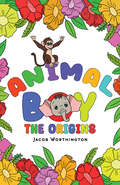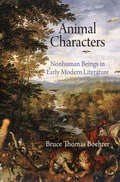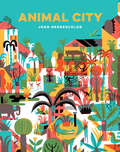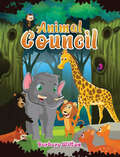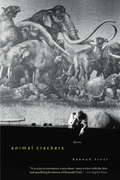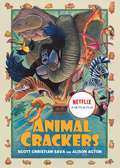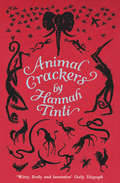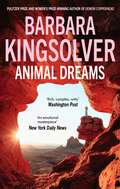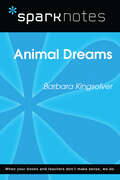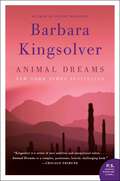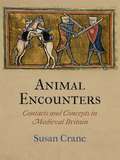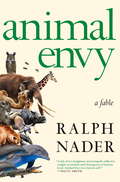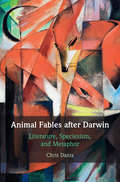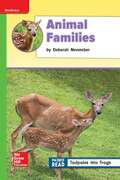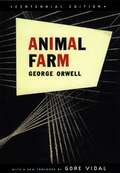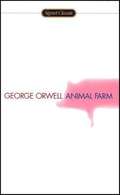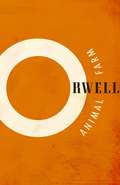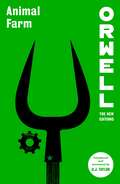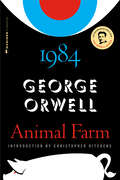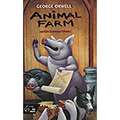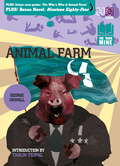- Table View
- List View
Animal Boy: the Origins
by Jacob WorthingtonOn Jacob’s first day as an Official Inventions Observer (O.I.O.), an unexpected twist of fate changes his life forever. Follow the journey of this young hero as he uncovers the mystery behind his newfound powers and takes on his very first mission: to solve the disappearance of the local zoo’s red pandas.
Animal Characters
by Bruce Thomas BoehrerDuring the Renaissance, horses--long considered the privileged, even sentient companions of knights-errant--gradually lost their special place on the field of battle and, with it, their distinctive status in the world of chivalric heroism. Parrots, once the miraculous, articulate companions of popes and emperors, declined into figures of mindless mimicry. Cats, which were tortured by Catholics in the Middle Ages, were tortured in the Reformation as part of the Protestant attack on Catholicism. And sheep, the model for Agnus Dei imagery, underwent transformations at once legal, material, and spiritual as a result of their changing role in Europe's growing manufacturing and trade economies. While in the Middle Ages these nonhumans were endowed with privileged social associations, personal agency, even the ability to reason and speak, in the early modern period they lost these qualities at the very same time that a new emphasis on, and understanding of, human character was developing in European literature.In Animal Characters Bruce Thomas Boehrer follows five species--the horse, the parrot, the cat, the turkey, and the sheep--through their appearances in an eclectic mix of texts, from romances and poetry to cookbooks and natural histories. He shows how dramatic changes in animal character types between 1400 and 1700 relate to the emerging economy and culture of the European Renaissance. In early modern European culture, animals not only served humans as sources of labor, companionship, clothing, and food; these nonhuman creatures helped to form an understanding of personhood. Incorporating readings of Shakespeare's plays, Milton's Paradise Lost, Margaret Cavendish's Blazing World, and other works, Boehrer's series of animal character studies illuminates a fascinating period of change in interspecies relationships.
Animal City
by Joan NegrescolorNina journeys to a secret jungle city populated by animals, plants, and lost objects. The reason for her visit: story hour, where a book's power holds the wild in thrall. The animals are eager for stories about space, the sea, and other worlds. But their favorite story of all is the one told here: a story about a mysterious place, laden with legend and lore, and now overtaken by nature. Five Pantone colors infuse each illustrated spread with a vibrant, electric energy, making this powerful celebration of nature—and stories—as vivid visually as its narrative is engrossing.
Animal Council
by Barbara WiltonImagine yourself in the forest wilds. If you saw some animals grouped together, what would you wonder? What are they talking about? Do they plan and discuss things just like people? There must be issues that confront animals that people don’t even think about. Just like people, every animal has a talent to contribute to the group. Which ones are the most valuable because they get the best results? Is it the big, powerful ones like the elephant and the lion, or the less noticed, unexpected ones? Take yourself on a journey to the forest and discover what really goes on.
Animal Crackers
by Hannah TintiA zoo worker, cautiously washing down Marysue the elephant, considers the strange, grim fragments he's heard of his co-workers' lives. Giraffes demand better living conditions and stage a mock group suicide. A girl escapes her repressive finishing school to find freedom with the monkeys in the African jungle. Snake or dog, buffalo, cat or turkey, each animal in Hannah Tinti's brilliant, darkly comic collection holds up a disturbing mirror to the human beings around it.
Animal Crackers (Animal Crackers)
by Scott Christian SavaIt was supposed to an exciting, yet normal trip to the circus.Dangerous stunts, flying acrobats, and even the clowns Uncle Doug hated so much—Owen is itching to see all of it. But when his little sister Zoe, a self-proclaimed animal whisperer, accuses the ringmaster of mistreating the circus animals, the last thing Owen has time to do is to watch the show! With the help of some magical animal crackers that can transform him into a bear, a hippo, or even a hamster, Owen sets out to rescue his kidnapped uncle and sister from the hands of the scheming ringmaster and his circus lackeys.
Animal Crackers: Circus Mayhem (Animal Crackers)
by Scott Christian SavaHow does Uncle Bob do it? Owen couldn't figure it out.Buffalo Bob's Rootin' Tootin' Animal Circus is famous for its jump-roping giraffe, tangoing lion, and knife-throwing elephant. But they have to be fakes, right? Owen is determined to get to the bottom of this mystery. When he visits the circus he discovers that his uncle and, coincidentally, all of the animals, are missing. It can only be the work of Buffalo Bob’s sideshow rival: Contorto.Owen stumbles upon the one thing that can save the day: Buffalo Bob’s box of animal crackers. But these aren’t any ordinary cookies: one bite and you’re transformed into a circus animal! The audience is wowed by Owen’s animal antics, but it will take more than a few carnival tricks to defeat Contorto and his pack of goons.
Animal Crackers: Stories
by Hannah TintiWith bravura storytelling, daring imagination, and fierce narrative control, this dazzling debut introduces that rare writer who finds humanity in our most unconventional behavior, and the humor beneath our darkest impulses.In these ten strange, funny, and unnerving stories, animals become the litmus test of our deepest fears and longings. In the title story, an elephant keeper courts danger from his gentle charge; in "Miss Waldron's Red Colobus," a headstrong young woman in Africa is lured by the freedom of the monkeys in the trees; in "Talk Turkey," a boy has secret conversations with the turkeys on his friend's family's farm; in "Slim's Last Ride," a child plays chilling games with his pet rabbit; in "Gallus Gallus," a pompous husband projects his anger at his wife onto her prized rooster.This fresh, inventive debut will introduce Hannah Tinti as one of the most gifted writers of her generation. Enter her world at your own risk, and you will come away bewitched.From the Hardcover edition.
Animal Crackers: Stories
by Hannah TintiWith bravura storytelling, daring imagination, and fierce narrative control, this dazzling debut introduces that rare writer who finds humanity in our most unconventional behavior, and the humor beneath our darkest impulses.In these ten strange, funny, and unnerving stories, animals become the litmus test of our deepest fears and longings. In the title story, an elephant keeper courts danger from his gentle charge; in “Miss Waldron’s Red Colobus,” a headstrong young woman in Africa is lured by the freedom of the monkeys in the trees; in “Talk Turkey,” a boy has secret conversations with the turkeys on his friend’s family’s farm; in “Slim’s Last Ride,” a child plays chilling games with his pet rabbit; in “Gallus Gallus,” a pompous husband projects his anger at his wife onto her prized rooster.This fresh, inventive debut will introduce Hannah Tinti as one of the most gifted writers of her generation. Enter her world at your own risk, and you will come away bewitched.From the Hardcover edition.
Animal Crackers: Stories
by Hannah TintiA zoo worker, cautiously washing down Marysue the elephant, considers the strange, grim fragments he's heard of his co-workers' lives. Giraffes demand better living conditions and stage a mock group suicide. A girl escapes her repressive finishing school to find freedom with the monkeys in the African jungle. Snake or dog, buffalo, cat or turkey, each animal in Hannah Tinti's brilliant, darkly comic collection holds up a disturbing mirror to the human beings around it.
Animal Dreams
by Barbara KingsolverFrom Barbara Kingsolver, the acclaimed author of Flight Behavior, The Lacuna, The Bean Trees, and other modern classics, Animal Dreams is a passionate and complex novel about love, forgiveness, and one woman's struggle to find her place in the world.At the end of her rope, Codi Noline returns to her Arizona home to face her ailing father, with whom she has a difficult, distant relationship. There she meets handsome Apache trainman Loyd Peregrina, who tells her, 'If you want sweet dreams, you've got to live a sweet life'.Filled with lyrical writing, Native American legends, a tender love story, and Codi's quest for identity, Animal Dreams is literary fiction at its very best.
Animal Dreams (SparkNotes Literature Guide Series)
by SparkNotesAnimal Dreams (SparkNotes Literature Guide) by Barbara Kingsolver Making the reading experience fun! Created by Harvard students for students everywhere, SparkNotes is a new breed of study guide: smarter, better, faster. Geared to what today's students need to know, SparkNotes provides: chapter-by-chapter analysis explanations of key themes, motifs, and symbols a review quiz and essay topics Lively and accessible, these guides are perfect for late-night studying and writing papers.
Animal Dreams: A Novel (P. S. Series)
by Barbara Kingsolver“An emotional masterpiece . . . A novel in which humor, passion, and superb prose conspire to seize a reader by the heart and by the soul.” —New York Daily NewsFrom Barbara Kingsolver, the acclaimed author of Flight Behavior, The Lacuna, The Bean Trees, and other modern classics, Animal Dreams is a passionate and complex novel about love, forgiveness, and one woman’s struggle to find her place in the world"Animals dream about the things they do in the daytime just like people do. If you want sweet dreams, you've got to live a sweet life." So says Loyd Peregrina, a handsome Apache trainman and latter-day philosopher. But when Codi Noline returns to her hometown, Loyd's advice is painfully out of her reach. Dreamless and at the end of her rope, Codi comes back to Grace, Arizona, to confront her past and face her ailing, distant father. What she finds is a town threatened by a silent environmental catastrophe, some startling clues to her own identity, and a man whose view of the world could change the course of her life.Blending flashbacks, dreams, and Native American legends, Animal Dreams is a suspenseful love story and a moving exploration of life's largest commitments.This edition includes a P.S. section with additional insights from Barbara Kingsolver, background material, suggestions for further reading, and more.
Animal Encounters
by Susan CraneTraces of the living animal run across the entire corpus of medieval writing and reveal how pervasively animals mattered in medieval thought and practice. In fascinating scenes of cross-species encounters, a raven offers St. Cuthbert a lump of lard that waterproofs his visitors' boots for a whole year, a scholar finds inspiration for his studies in his cat's perfect focus on killing mice, and a dispossessed knight wins back his heritage only to give it up again in order to save the life of his warhorse. Readers have often taken such encounters to be merely figurative or fanciful, but Susan Crane discovers that these scenes of interaction are firmly grounded in the intimate cohabitation with animals that characterized every medieval milieu from palace to village. The animal encounters of medieval literature reveal their full meaning only when we recover the living animal's place within the written animal.The grip of a certain humanism was strong in medieval Britain, as it is today: the humanism that conceives animals in diametrical opposition to humankind. Yet medieval writing was far from univocal in this regard. Latin and vernacular works abound in other ways of thinking about animals that invite the saint, the scholar, and the knight to explore how bodies and minds interpenetrate across species lines. Crane brings these other ways of thinking to light in her readings of the beast fable, the hunting treatise, the saint's life, the bestiary, and other genres. Her substantial contribution to the field of animal studies investigates how animals and people interact in culture making, how conceiving the animal is integral to conceiving the human, and how cross-species encounters transform both their animal and their human participants.
Animal Envy
by Ralph NaderRalph Nader's newest work of the imagination, Animal Envy, is a fable about the kinds of intelligences that are all around us in other animals. What would animals tell us—about themselves, about us—if there were a common language among all animal species? A bracingly simple idea, one that has been used before in books like George Orwell's Animal Farm and E. B. White's Charlotte's Web among others, but never like this. In Animal Envy, Ralph Nader proposes, quite plausibly, that a programmer has created a "digital translation" app whereby animals of different species, from insects to whales, can speak to one another, and through a "hyper-advanced converter" these animals can then also speak, both collectively and individually, to humans. It is decided that there will be a global assembly. It will be called "The Great Talkout." Humans are persuaded to reserve 100 hours of network coverage so The Great Talkout may begin and will be viewed by humans everywhere, in all human languages, as well as all animal languages. The narrative that ensues is deeply felt and powerfully informed. Just as he did when he wrote Only the Super-Rich Can Save Us, Nader shows here that his visionary genius knows no limits.From the Hardcover edition.
Animal Fables after Darwin: Literature, Speciesism, and Metaphor
by Chris DantaThe ancient form of the animal fable, in which the characteristics of humans and animals are playfully and educationally intertwined, took on a wholly new meaning after Darwin's theory of evolution changed forever the relationship between humans and animals. In this original study, Chris Danta provides an important and original account of how the fable was adopted and re-adapted by nineteenth- and twentieth-century authors to challenge traditional views of species hierarchy. The rise of the biological sciences in the second half of the nineteenth century provided literary writers such as Robert Louis Stevenson, H. G. Wells, Franz Kafka, Angela Carter and J. M. Coetzee with new material for the fable. By interrogating the form of the fable, and through it the idea of human exceptionalism, writers asked new questions about the place of the human in relation to its biological milieu.
Animal Farm
by George Orwell Ann PatchettGeorge Orwell's timeless fable--a parable for would-be liberators everywhere, glimpsed through the lens of our own history. As ferociously fresh as it was more than a half century ago, this remarkable allegory of a downtrodden society of overworked, mistreated animals, and their quest to create a paradise of progress, justice, and equality is one of the most scathing satires ever published. As we witness the rise and bloody fall of the revolutionary animals, we begin to recognize the seeds of totalitarianism in the most idealistic organization; and in our most charismatic leaders, the souls of our cruelest oppressors. With a foreword by Ann Patchett
Animal Farm
by George Orwell Russell Baker C. M. WoodhouseRevisit Orwell’s 1946 classic satire Animal Farm As ferociously fresh as it was more than a half century ago, this remarkable allegory of a downtrodden society of overworked, mistreated animals and their quest to create a paradise of progress, justice, and equality is one of the most scathing satires ever published. As readers witness the rise and bloody fall of the revolutionary animals, they begin to recognize the seeds of totalitarianism in the most idealistic organization—and in the most charismatic leaders, the souls of the cruelest oppressors. Note: Does not use standard American spellings.
Animal Farm
by George OrwellA stunning hardback edition of the classic novel.Animal Farm is one of the most famous warnings ever written. Orwell's immortal satire -- 'against Stalin' as he wrote to his French translator -- can be read on many levels. With its piercing clarity and deceptively simple style it is no surprise that this novel is required reading for schoolchildren and politicians alike. This fable of the steadfast horses Boxer and Clover, the opportunistic pigs Snowball and Napoleon, and the deafening choir of sheep remains an unparalleled masterpiece.One reviewer wrote "In a hundred years' time perhaps Animal Farm... may simply be a fairy story: today it is a fairy story with a good deal of point." Over sixty years on in the age of spin, it is more relevant than ever.Rejected by such eminent publishing figures as Victor Gollancz, Jonathan Cape and T.S. Eliot, Animal Farm was published to great acclaim by Martin Secker and Warburg on August 17, 1945 in an edition of 4500 copies. In the centenary year of Martin Secker, Ltd., Harvill Secker is proud to publish this special edition with a new introduction.
Animal Farm (Orwell: The New Editions)
by George OrwellA new edition of Orwell's savage satire of the Soviet Revolution, introduced and annotated by his biographer, D.J. TaylorFirst published in 1945, just as the allied forces had begun to parcel up the post-war world, Orwell's satire of the Soviet Revolution was instantly acclaimed as a Cold War classic. Set in the English countryside in the early years of the twentieth century, this is the story of a rebellion that fails, carried out by revolutionaries who all too swiftly turn into the thing they were trying to destroy.This new edition includes an introduction and extensive end-notes, and an appendix containing original responses to the novel as well as letters and documents from the period in which Animal Farm was written.
Animal Farm (With Related Readings)
by George OrwellThe World History and World Geography Library consists of novels and other full-length works, related readings, and study guides you can use for small group or whole-class instruction. Study Guides offer instructional support and student activities for works from the Library. They include extensive back-ground on the author and the work, lesson plans for the work and the Related Readings, blackline master activities, cross-curricular connections, audiovisual recommendations; and assessment.
Animal Farm and 1984: Two Volumes In One
by George Orwell Christopher Hitchens A. M. HeathGeorge Orwell's two subversive masterpieces--now together in one edition--are "weapons of self-respect as well as of self-defense," writes Christopher Hitchens in his introduction. Animal FarmA biting satire of the Russian Revolution, Animal Farm imagines a wholly democratic society built on the credo that All Animals Are Created Equal. The pigs Napoleon, Squealer, and Snowball emerge as leaders of the new community in a subtle evolution that leads to the brutal betrayal of the faithful horse Boxer and reestablishes totalitarian rule, adding an unforgettable bloodstained postscript to their founding slogan. 1984London, 1984: Big Brother is watching, and the Thought Police are always one step ahead of you. Winston Smith is a man in grave danger for the simple reason that his memory still functions. Drawn into a forbidden love affair, Winston finds the courage to join a secret revolutionary organization called The Brotherhood, dedicated to the destruction of the Party. Together with his beloved Julia, he risks his life in a deadly fight for freedom.
Animal Farm with Connections
by George OrwellA political satire, originally published with the title "Animal Farm: A Fairy Story", is an allegorical novella by George Orwell. According to Orwell, the book reflects events leading up to the Russian Revolution of 1917 and then on into the Stalinist era of the Soviet Union.
Animal Farm: 2 books in 1 edition (Bookmine #1)
by George OrwellEnter Manor Farm, owned by Mr Jones, a lazy farmer who ignores the plight of the animals who toil under his yoke. However, things change dramatically after Major, the prizewinning boar, has a dream, in which all the animals are free. His rousing speeches incite the animals to revolt against oppression. Egged on by the promise of freedom, the animals unite and drive the Joneses out of the farm. Under the tutelage of the pigs, all the farm animals build a world where they are free and equal. Until some become more equal than others. Does the dream of freedom become a nightmare of slavery?George Orwell’s classic, first published in 1945, continues to mirror what unfolds in the theatres of power in society. His criticism of the communist ideal of an equal world takes you through the shining triumphs and terrible failures of the world we live in. PLUS! Book Mine Gems: 34 extra-special pages: Know more about the author, his work and his times.to do.'
